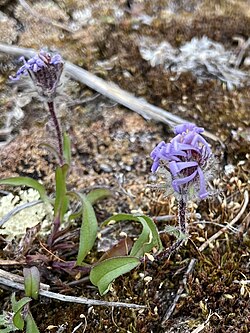| Symphyotrichum pygmaeum | |
|---|---|
 | |
| Victoria Island, Kitikmeot Region, Nunavut, Canada | |
| Scientific classification | |
| Kingdom: | Plantae |
| Clade: | Tracheophytes |
| Clade: | Angiosperms |
| Clade: | Eudicots |
| Clade: | Asterids |
| Order: | Asterales |
| Family: | Asteraceae |
| Tribe: | Astereae |
| Subtribe: | Symphyotrichinae |
| Genus: | Symphyotrichum |
| Subgenus: | Symphyotrichum subg. Virgulus |
| Section: | Symphyotrichum sect. Grandiflori |
| Species: | S. pygmaeum |
| Binomial name | |
| Symphyotrichum pygmaeum | |
 | |
| Native distribution [3] | |
| Synonyms [2] | |
Basionym
Other synonyms | |
Symphyotrichum pygmaeum (formerly Eurybia pygmaea and Aster pygmaeus) is a species of flowering plant in the family Asteraceae. Commonly known as pygmy aster, it is a perennial, herbaceous plant that may reach heights of 1.5 to 15 centimeters (1⁄2 to 6 inches). Its summer-blooming flowers have purple to violet ray florets and yellow disk florets. [4]


